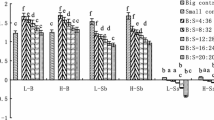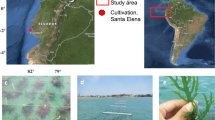Abstract
Sea cucumber, Apostichopus japonicus, is the main cultured species in China. The main culture style for this species is the sea ranching model. Field trials were conducted in bottom-cages to preliminary reveal optimal releasing size, as well as maximum density of A. japonicus in an integrated multi-trophic aquaculture sea ranching area. Different sizes (4–30 g ind−1) and densities (336–1342 g m−2) of sea cucumbers were cultured for 13 months in Rongcheng Bay, Shandong Province, China. The size experiment showed that sea cucumber of all sizes grew throughout the experimental period. Sea cucumbers <15 g had high mortality in summer and low SGR in winter, while larger individual (>20 g ind−1) had no advantage of growth. Sea cucumber sizes of 15–20 g may be suitable for release, considering their higher survival rate and SGR. The density experiment showed that the high biomass group had a low SGR and that the maximum release biomass was 793 g m−2 based on a regression analysis. The optimal practical release season for sea cucumber was spring based on the results of two field experiments.






Similar content being viewed by others
References
Anderson SC, Flemming JM, Watson R, Lotze HK (2010) Serial exploitation of global sea cucumber fisheries. Fish Fish 12:317–339
Antonette Juinio-Menez M, Evangelio JC, Miralao SJA (2014) Trial grow-out culture of sea cucumber Holothuria scabra in sea cages and pens. Aquac Res 45:1332–1340
Beltran-Gutierrez M, Ferse SCA, Kunzmann A, Stead SM, Msuya FE, Hoffmeister TS, Slater MJ (2014) Co-culture of sea cucumber Holothuria scabra and red seaweed Kappaphycus striatum. Aquac Res. doi:10.1111/are.12615
Chen J (2003) Overview of sea cucumber farming and sea ranching practices in China. SPC Beche-de-mer Inf Bull 18:18–23
Chen J (2005) Present status and prospects of sea cucumber industry in China. FAO fish technical paper, pp 25–38
Dong S, Liang M, Gao Q, Wang F, Dong Y, Tian X (2010) Intra-specific effects of sea cucumber (Apostichopus japonicus) with reference to stocking density and body size. Aquac Res 41:1170–1178
Hu F, Gao X, Wang Z, Li M, Zhou W, Ma D, Li S, Zhang Y (2011) Studies on dormancy rule of Apostichopus japonicus. Fish Moder 38: 37–40 + 55 (in Chinese with English abstract)
Li YQ, Li J, Wang QY (2006) The effects of dissolved oxygen concentration and stocking density on growth and non-specific immunity factors in Chinese shrimp, Fenneropenaeus chinensis. Aquaculture 256:608–616
Liang M, Dong S, Gao Q, Wang F, Tian X (2010) Individual variation in growth in sea cucumber Apostichopus japonicus (Selenck) housed individually. J Ocean Univ China 9:291–296
Luczak C, Janquin M-A, Kupka A (1997) Simple standard procedure for the routine determination of organic matter in marine sediment. Hydrobiologia 345:87–94
MacDonald CL, Stead SM, Slater MJ (2013) Consumption and remediation of European Seabass (Dicentrarchus labrax) waste by the sea cucumber Holothuria forskali. Aquac Int 21:1279–1290
Ming-zhi Y, Ya-qing C (2008) The effects of low temperature on some physiological phenomena in different populations of sea cucumber Apostichopus japonicus juveniles. J Dalian Fish Univ 23:31–36
Nelson EJ, MacDonald BA, Robinson SMC (2012) The absorption efficiency of the suspension-feeding sea cucumber, Cucumaria frondosa, and its potential as an extractive integrated multi-trophic aquaculture (IMTA) species. Aquaculture 370–371:19–25
Neori A, Chopin T, Troell M, Buschmann AH, Kraemer GP, Halling C, Shpigel M, Yarish C (2004) Integrated aquaculture: rationale, evolution and state of the art emphasizing seaweed biofiltration in modern mariculture. Aquaculture 231:361–391
Pei S, Dong S, Wang F, Tian X, Gao Q (2012a) Effects of density on variation in individual growth and differentiation in endocrine response of Japanese sea cucumber (Apostichopus japonicus Selenka). Aquaculture 356–357:398–403
Pei S, Dong S, Wang F, Gao Q, Tian X (2012b) Effects of stocking density and body physical contact on growth of sea cucumber, Apostichopus japonicus. Aquac Res 45:629–636
Purcell SW, Blockmans BF (2009) Effective fluorochrome marking of juvenile sea cucumbers for sea ranching and restocking. Aquaculture 296:263–270
Purcell SW, Simutoga M (2008) Spatio-temporal and size-dependent variation in the success of releasing cultured sea cucumbers in the wild. Rev Fish Sci 16:204–214
Purcell SW, Mercier A, Conand C, Hamel J-F, Veronica Toral-Granda M, Lovatelli A, Uthicke S (2013) Sea cucumber fisheries: global analysis of stocks, management measures and drivers of overfishing. Fish Fish 14:34–59
Qin C, Dong S, Tan F, Tian X, Wang F, Dong Y, Gao Q (2009) Optimization of stocking density for the sea cucumber, Apostichopus japonicus Selenka, under feed-supplement and non-feed-supplement regimes in pond culture. J Ocean Univ China 8:296–302
Qiu T, Zhang L, Zhang T, Bai Y, Yang H (2014) Effect of culture methods on individual variation in the growth of sea cucumber Apostichopus japonicus within a cohort and family. Chin J Oceanol Limnol 32:737–742
Slater MJ (2015) Use and exploitation of sea cucumbers. In: Brown N, Eddy S (eds) Echinoderm aquaculture. Wiley, New Jersey, p 384
Slater MJ, Carton AG (2007) Survivorship and growth of the sea cucumber Australostichopus (Stichopus) mollis (Hutton 1872) in polyculture trials with green-lipped mussel farms. Aquaculture 272:389–398
Slater MJ, Carton AG (2009) Effect of sea cucumber (Australostichopus mollis) grazing on coastal sediments impacted by mussel farm deposition. Mar Pollut Bull 58:1123–1129
Slater MJ, Jeffs AG, Carton AG (2009) The use of the waste from green-lipped mussels as a food source for juvenile sea cucumber, Australostichopus mollis. Aquaculture 292:219–224
Troell M, Joyce A, Chopin T, Neori A, Buschmann AH, Fang J-G (2009) Ecological engineering in aquaculture—potential for integrated multi-trophic aquaculture (IMTA) in marine offshore systems. Aquaculture 297:1–9
Wang W, Ji Y, Liu H, Sun P (2012) Research of Apostichopus japonicus proliferation shallow seabed sowing technology. Aquaculture 03:25–26 (in Chinese)
Xia S, Yang H, Li Y, Liu S, Xu Q, Rajkumar M (2013) Effects of food processing method on digestibility and energy budget of Apostichopus japonicus. Aquaculture 384:128–133
Xu Q, Zhang L, Zhang T, Zhou Y, Xia S, Liu H, Yang H (2014) Effects of an artificial oyster shell reef on macrobenthic communities in Rongcheng Bay, East China. Chin J Oceanol Limnol 32:99–110
Yang H, Yuan X, Zhou Y, Mao Y, Zhang T, Liu Y (2005) Effects of body size and water temperature on food consumption and growth in the sea cucumber Apostichopus japonicus (Selenka) with special reference to aestivation. Aquac Res 36:1085–1092
Yu Z, Zhou Y, Yang H, Ma YE, Hu C (2014) Survival, growth, food availability and assimilation efficiency of the sea cucumber Apostichopus japonicus bottom-cultured under a fish farm in southern China. Aquaculture 426:238–248
Yuan X, Yang H, Zhou Y, Mao Y, Zhang T, Liu Y (2006) The influence of diets containing dried bivalve feces and/or powdered algae on growth and energy distribution in sea cucumber Apostichopus japonicus (Selenka) (Echinodermata: Holothuroidea). Aquaculture 256:457–467
Zamora LN, Jeffs AG (2012) The ability of the deposit-feeding sea cucumber Australostichopus mollis to use natural variation in the biodeposits beneath mussel farms. Aquaculture 326:116–122
Zhang L, Zhang T, Xu Q, Qiu T, Yang H, Liu S (2014) An artificial oyster-shell reef for the culture and stock enhancement of sea cucumber, Apostichopus japonicus, in shallow seawater. Aquac Res. doi:10.1111/are.12383
Zhou Y, Yang H, Liu S, Yuan X, Mao Y, Liu Y, Xu X, Zhang F (2006) Feeding and growth on bivalve biodeposits by the deposit feeder Stichopus japonicus Selenka (Echinodermata: Holothuroidea) co-cultured in lantern nets. Aquaculture 256:510–520
Acknowledgments
This work was supported by the Natural Science Foundation of China (No. 41406164), the National Marine Public Welfare Research Project (No. 201305043), and the National Key Technology R&D Program (Nos. 2011BAD13B02, 2010BAC68B01) and Key Laboratory of Marine Ecology and Environmental Science and Engineering, SOA (MESE-2013-05), Important Specialized Science and Technology Project in Shandong province (NO. 2015ZDZX05002) and Agricultural major technology innovation project of Shandong province: breeding, technology and equipment of high quality sea cucumber.
Author information
Authors and Affiliations
Corresponding authors
Rights and permissions
About this article
Cite this article
Qinzeng, X., Libin, Z., Xuelei, Z. et al. Release size and stocking density for grow-out of Apostichopus japonicus in the sea with raft-cultured macroalgae. Aquacult Int 24, 1141–1152 (2016). https://doi.org/10.1007/s10499-016-9976-1
Received:
Accepted:
Published:
Issue Date:
DOI: https://doi.org/10.1007/s10499-016-9976-1




